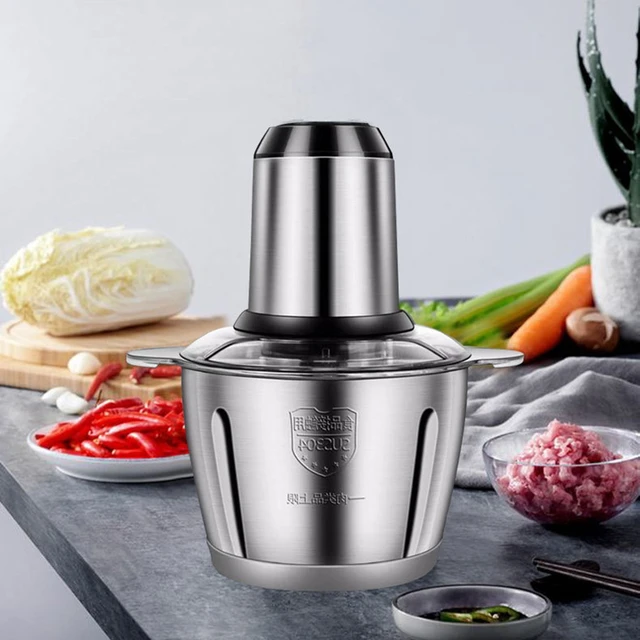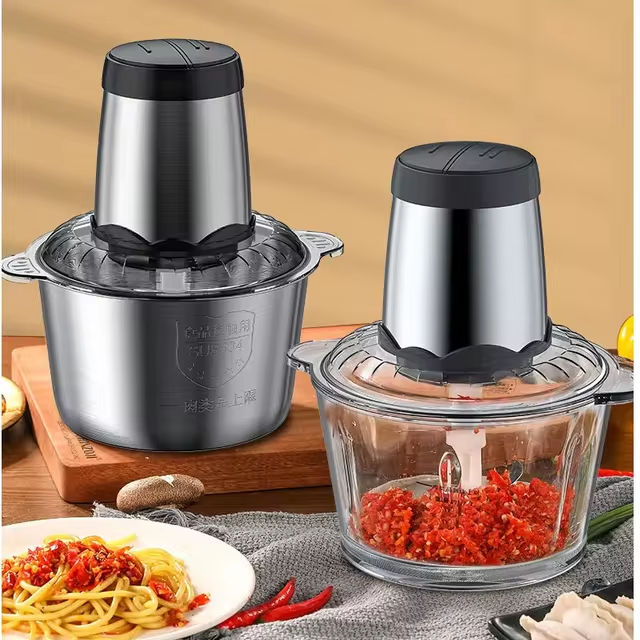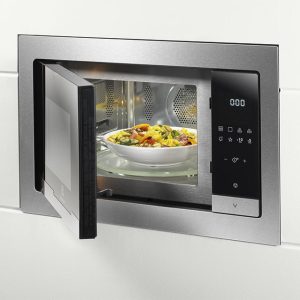
The kitchen is the heart of the home, a revolving theater of culinary delights where the choice of tools can make or break the performance. Two of the most commonly used appliances are the food processor and the blender. While they may seem similar at first glance, they serve distinct functions and cater to different culinary needs. So, what is a food processor vs blender? In this comprehensive guide, we will delve into the key differences, individual functions, and specific use-cases, helping you make an informed decision on which appliance suits your culinary endeavors.
The Basics: What is a Food Processor?
A food processor is a versatile kitchen appliance designed to facilitate a range of repetitive cooking tasks. Its main functions include chopping, slicing, dicing, and shredding. It often comes equipped with various interchangeable blades and discs, allowing you to tailor its form and function based on the activity at hand.
Functions and Capabilities of a Food Processor
Chopping and Grinding
The primary function of a food processor is to chop and grind food items. Whether you’re preparing a chunky salsa, finely chopping herbs, or grinding nuts, the robust blades do so with precision and speed.
Slicing and Shredding
With the interchangeable discs, a food processor can seamlessly slice vegetables for salads, shred cheese for pizzas, or julienne carrots for a stir-fry. This flexibility makes meal prep faster and more efficient.
Mixing and Kneading Dough
Many food processors come with a dough blade which can be used to mix and knead dough for bread, pizzas, and even pastries. This is something a blender cannot accomplish, setting the food processor apart.
Pureeing and Emulsifying
While not its primary function, food processors can also be used to puree ingredients into a coarse mixture or to emulsify sauces and dressings. Though a blender is more commonly used for these tasks, the food processor does an adequate job for recipes that require less fineness.
The Basics: What is a Blender?
A blender is an equally valuable appliance, but it serves a different set of purposes. Blenders are primarily used for liquids and softer foods, perfect for making smoothies, soups, and purees. It typically features a jar with a fixed blade that rotates at high speeds to pulverize its contents into a smooth consistency.
Functions and Capabilities of a Blender
Blending and Pureeing
The primary use of a blender is in its namesake – blending. It is adept at combining liquids and soft foods into a homogeneous mixture, making it ideal for smoothies, soups, and baby foods.
Crushing Ice and Frozen Ingredients
A powerful blender can crush ice and blend frozen fruits, enabling the creation of frozen drinks and sorbets. This particular function is something a food processor may struggle with due to its different blade design and motor setup.
Creating Emulsions
Blenders excel at creating smooth emulsions, such as mayonnaise or salad dressings. The high-speed blades thoroughly mix oil, vinegar, and other ingredients, resulting in a creamy and well-combined end product.
Grinding and Churning
Though not typically its primary function, some high-powered blenders can also grind grains and coffee beans and churn out nut butter. These specialized tasks, however, often require a blender of commercial-grade power.
Key Differences: Food Processor vs Blender
Understanding the different functions and capabilities between a food processor and a blender helps in distinguishing their primary applications. Below are some key differences that can guide you in choosing the right tool for your kitchen.
Versatility and Use Cases
Food Processor
The food processor’s versatility lies in its array of blades and discs that can perform various tasks, from chopping onions to kneading dough. It’s a multi-tasker designed for a wide range of food preparation activities.
Blender
On the other hand, a blender shines in tasks involving liquids and softer foods. It’s the go-to appliance for smoothies, purees, and soups, but less versatile when it comes to handling solid or tougher ingredients.
Functionality and Design
Food Processor
A food processor usually has a wide mixing bowl offered in various sizes, a motorized base, and multiple attachments. Its design focuses on facilitating different textures and sizes of food, making it a jack-of-all-trades in the kitchen.
Blender
Conversely, a blender is generally tall with a narrower container and fixed blade at the bottom. Its motor is designed to operate at high speeds, ensuring smooth and even blending of its contents.
Feasibility in Daily Use
Food Processor
The food processor is an asset for daily meal prep. Its primary advantage lies in cutting down the time required for labor-intensive tasks like chopping vegetables or shredding cheese.
Blender
A blender excels in daily use for anyone who enjoys smoothies or needs to puree ingredients frequently. For families with young children, the ease of making baby food can be immensely valuable.
Specific Use-Cases in the Kitchen
Understanding when to use a food processor vs blender can prove to be a game-changer in your culinary endeavors. Below are some specific use-cases for each appliance, to help you choose wisely.
Meal Preparation
Food Processor
- Chopping and Dicing Vegetables: Perfect for quickly preparing the base ingredients for soups, stews, and salads.
- Shredding Cheese: Saves you the laborious task of manually grating cheese.
- Kneading Dough: A game-changer for homemade breads and pastries, mini food processors even allow small batch preparation.
Blender
- Smoothies and Shakes: Ideal for blending fruits, vegetables, and liquids into a smooth consistency.
- Pureed Soups: Great for making creamy soups like butternut squash or tomato bisque.
- Frozen Drinks: Perfect for cocktails, smoothies, and other frozen beverages.
Specialized Applications
Food Processor
- Making Nut Butters: The robust motor and sharp blades make easy work of grinding nuts into a creamy consistency.
- Cauliflower Rice: Quickly turns a head of cauliflower into rice-size pieces, perfect for low-carb diets.
- Pesto and Sauces: While a blender can do this, a food processor allows for a chunkier, more rustic texture if desired.
Blender
- Homemade Ice Cream: High-powered blenders can blend frozen fruit into a creamy dessert.
- Emulsions: Ideal for creating a smooth, stable emulsion for salad dressings or mayonnaise.
- Grinding Coffee Beans: Some powerful blenders can double as a coffee grinder, saving counter space.
Choosing the Right Appliance for Your Needs
The decision of choosing a food processor vs blender ultimately boils down to your specific needs and cooking habits. Here are factors to consider:
Frequency of Use
Food Processor
If your cooking frequently involves chopping vegetables, grating cheese, or kneading dough, a food processor will save you significant prep time.
Blender
If you regularly enjoy smoothies, soups, or frozen drinks, a blender will serve as a more specialized tool for these tasks.
Kitchen Space and Budget
Food Processor
Food processors can be bulkier and may take up more counter space. They are generally more expensive due to their versatility, but the investment pays off if your cooking style aligns with its capabilities.
Blender
Blenders generally have a smaller footprint and can be less expensive, especially for those who don’t require high-powered models. They are a good investment for simple blending tasks and liquid-based recipes.
Skill Level and Comfort
Food Processor
For those who enjoy experimenting in the kitchen and tackling a variety of recipes, the food processor offers a range of functionalities that can elevate the cooking experience.
Blender
For users who prefer straightforward operations with predictable outcomes, such as making smoothies or creamy soups, a blender is easier to use and requires less fiddling with attachments and settings.
 Maintenance and Cleaning
Maintenance and Cleaning
Maintenance and cleaning are important aspects to consider when choosing between a food processor and a blender. How easy an appliance is to clean can influence how often you use it.
Food Processor Cleaning Protocols
Food processors often come with several parts, including blades, discs, and the bowl. While many of these parts are dishwasher-safe, manually washing might be necessary to ensure longevity.
Blender Cleaning Protocols
Blenders typically feature fewer parts, making them slightly easier to clean. Most blender jars can be quickly rinsed out, and many models allow the jar to be placed in the dishwasher for thorough cleaning.
Durability Factors
Considering the longevity of each appliance can also help in making an educated buying decision. Both devices have robust elements, but their lifespans can vary based on the types of materials used and the frequency of use.
Conclusion: What is a Food Processor vs Blender?
In summary, the food processor and blender are both essential kitchen appliances, each excelling in its domain. The food processor offers a versatile range of functions, from chopping and slicing to kneading dough, making it a multi-faceted workhorse ideal for a variety of cooking tasks. The blender, on the other hand, shines in creating smooth, liquid-based preparations like smoothies, soups, and frozen drinks.
When considering what is a food processor vs blender, the key lies in understanding their unique features and functionalities. This understanding will allow you to choose the right appliance for your culinary needs, ensuring that you achieve the best possible results in your kitchen endeavors. Whether you choose a food processor, a blender, or both, the important thing is that these tools will greatly enhance your cooking experiences, making meal prep faster, easier, and more enjoyable.







